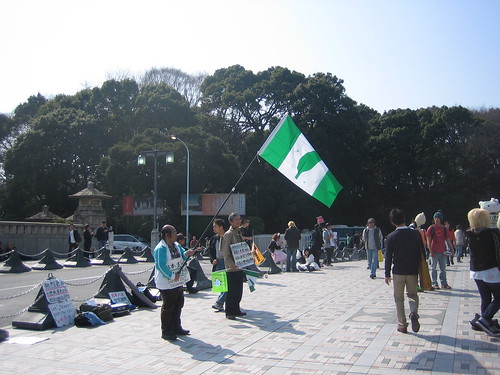One of my best friends in college was a Taiwanese guy firmly in the “green” (pro-independence) camp. We had many conversations about the symbolism of green in the independence movements of both Ireland and Taiwan. We were also both into vexillology, the study of flags, and we often compared the evolution of Irish flags to the evolution of flags in Taiwan.
Fast forward a few years. Today was the St Patrick’s Day parade down Omotesando in Tokyo. Much to my curiosity, there were a couple of elderly Taiwan independence protesters out with their green Taiwan independence flags, which made for an interesting comparison with the Irish tricolors hung from flagpoles farther down the avenue. It was also an interesting contrast with the typical crowd of subculture groupies and bemused foreigners that hang out by the entrance to Yoyogi Park.
Despite being color-coordinated for the occasion, they seemed rather lonely at their posts. Apparently getting Taiwan admitted to the UN is not high on the political priority list of most Tokyo residents.
For whatever reason, green is an underused national flag color once you go east of the Indian subcontinent and the extensive Islamic influence in that half of Asia. Macau has a nice green flag (as does Tokyo), but the nations of East and Southeast Asia have generally adopted red, white and blue in varying proportions, with yellow stars sprinkled here and there.
The consensus among books I’ve read and people I’ve spoken to is that green became associated with Ireland (and its native Catholics) simply because Ireland is a very green country–they don’t call it the “Emerald Isle” for nothing. (Although green is prominent in the flags of other Catholic countries–Italy, Portugal, Mexico and Brazil for instance–it doesn’t have religious significance in the stories behind any of these flags.)
Wikipedia’s explanation for the Taiwanese independence movement’s use of green is that the Democratic Progressive Party adopted green because environmentalism was a major part of its agenda, and the color eventually became associated with everything else the DPP advocated.
In both cases, it seems that green took on another meaning: it drew a sharp contrast to powerful adversaries who flew red and blue flags, namely the British in Ireland and the communists and Kuomintang in China and Taiwan. Then you have the United States, where the Green Party is the most popular (if you can call it that) alternative to the “red” and “blue” parties.
I’m not sure if there is really a point to these parallels, besides that people will find ways to divide themselves by color even when they’re all the same color to begin with. The Irish flag acknowledges this in its own way–it stands for peace (the white mid-section) between two opposing sides (the green Catholics and orange Protestants). Ireland eventually got this peace after a few decades of faking it. Who knows where Taiwan is headed–all I know is that I will support a green flag in Asia, because this part of the world is crying out for vexillological diversity.










